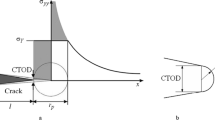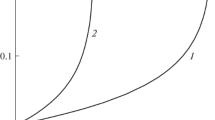We present some important theoretical and experimental results obtained in the field of fracture mechanics of materials and durability of structural elements. The main foundations (concepts) of the fracture mechanics and strength of cracked elastoplastic bodies are formulated and some urgent problems of advanced studies in this field of science of materials and their strength are posed. Some problems of the fatigue fracture and durability of metals operating in working media are also investigated.
Similar content being viewed by others
References
V. V. Panasyuk, Mechanics of Quasibrittle Fracture of Materials [in Russian], Naukova Dumka, Kiev (1991).
V. V. Panasyuk, “An outline of the development of fracture mechanics and strength of materials investigations,” in: Investigations on Fracture, Strength, and Integrity of Materials and Structures [in Ukrainian], Physicomechanical Institute, Lviv (1993), pp. 7–48.
H. P. Rossmanith, The Struggle for Recognition of Engineering Fracture Mechanics. Fracture Research in Retrospect (An Anniversary Volume in Honour of G. R. Irwin’s 90th Birthday), A. A. Balkema (Rotterdam) Brookfield (1997).
V. V. Panasyuk, “Fracture mechanics of materials is a new branch of science,” in: I. K. Pokhodnya (editor), Advanced Materials and Technologies [in Ukrainian], Vol. 2, Akademknyha, Kyiv (2003), pp. 501–524.
V. V. Panasyuk (editor), Fracture Mechanics and Strength of Materials. A Handbook [in Russian], Vols. 1–4, Naukova Dumka, Kiev (1988–1990).
S. Ya. Yarema, P. M. Vitvitskii, and A. P. Datsyshin, “First All-union conference ‘Fracture mechanics of materials’,” Fiz.-Khim. Mekh. Mater., 24, No. 1, 124–126 (1988).
V. V. Panasyuk, O. E. Andreikiv, L. M. Lobanov, D. M. Teplin, and N. V. Kuznyak, Fracture Mechanics: Advances and Problems (Book Survey of the MKR-8) [in Ukrainian], Physicomechanical Institute, Lviv (1994).
V. V. Panasyuk, Deformation Criteria in Fracture Mechanics of Materials [in Ukrainian], Physicomechanical Institute, Lviv (1993).
A. A. Griffith, “The theory of rupture,” in: Proc. 1st Internat. Conf. Appl. Mech., Delft (1924), p. 55.
G. R. Irwin, “Analysis of stresses and strains near the end of a crack, traversing a plate,” J. Appl. Mech., 24, No. 3, 361–364 (1957).
V. V. Panasyuk, O. E. Andreikiv, and S. E. Kovchik, Methods for the Evaluation of the Crack Resistance of Structural Materials [in Russian], Naukova Dumka, Kiev (1977).
K. V. Frolov (editor), Mechanics of Catastrophes. Determination of the Characteristics of Crack Resistance of Structural Materials: Methodical Recommendations [in Russian], KODAS, Moscow (1995).
S. Ya. Yarema, “A method for the evaluation of crack growth rates and the characteristics of cyclic crack-growth resistance of the metals,” Fiz.-Khim. Mekh. Mater., 30, No. 3, 137–152 (1994); 30, No. 4, 121–136 (1994); 30, No. 6, 101–112 (1994); 31, No. 1, 145–156 (1995).
V. V. Panasyuk (editor), Fracture Mechanics and Strength of Materials. A Handbook [in Russian], Vol. 3: S. E. Kovchik and E. M. Morozov, Characteristics of Short-Term Crack Resistance of Materials and the Methods Aimed at Their Evaluation, Naukova Dumka, Kiev (1988–1990).
ASTM Standard No. 399. Standard Test Method for Plane-Strain Fracture Toughness of Metallic Materials, Annual Book of ASTM Standards, Vol. 11.03 (1974).
V. V. Panasyuk and L. T. Berezhnitskii, “Determination of the ultimate forces in tension of a plate containing an arclike crack,” in: Problems of the Mechanics of Actual Solid Bodies [in Russian], Issue 3, Kiev (1964), pp. 3–19.
V. V. Panasyuk, L. T. Berezhnitskii, and S. E. Kovchik, “On the propagation of an arbitrarily oriented rectilinear crack,” Prikl. Mekh., 1, No. 2, 48–55 (1965).
A. E. Andreikiv, Three-Dimensional Problems of the Theory of Cracks [in Russian], Naukova Dumka, Kiev (1982).
N. A. Makhutov, V. V. Panasyuk, S. Ya. Yarema, et al., GOST 25.506-85. Strength Analyses and Tests. Methods for Mechanical Testing of Metals. Determination of the Characteristics of Crack Resistance (Fracture Toughness) Under Static Loading [in Russian], Izd. Goskomstandart SSSR, Moscow (1985).
W. F. Brown, Jr., and J. E. Srawley, Tests of High-Strength Materials for Plane-Strain Fracture Toughness [Russian translation], Mir, Moscow (1972).
V. V. Panasyuk, Ya. L. Ivanyts’kyi, and A. O. Andreikiv, “Methods for the evaluation of cyclic crack-growth resistance of materials in the case of realization of mixed macromechanisms of fracture,” in: Proc. Internat. Conf. “Evaluation and Substantiation of the Prolongation of Service Life of Structural Elements [in Ukrainian], Institute for Applied Problems in Mechanics and Mathematics, Lviv (2000).
V. V. Panasyuk, “Some problems of fracture mechanics and strength of materials,” in: V. V. Panasyuk (editor), Proc. 2nd Internat. Conf. “Fracture Mechanics of Materials and Strength of Structures” [in Ukrainian], Vol. 1, Issue 2, Kamenyar, Lviv (1999), pp. 9–20.
Ya. L. Ivanyts’kyi and S. T. Shtayura, “Methodical recommendations. Determination of the characteristics of crack resistance of materials under the conditions of complex stressed states,” in: V. V. Panasyuk (editor), Fracture Mechanics of Materials and Strength of Structures [in Ukrainian], Physicomechanical Institute, Lviv (2004), pp. 723–732.
Ya. L. Ivanyts’kyi, Methods for the Evaluation of Crack Resistance of Structural Materials Under the Conditions of Complex Loading [in Ukrainian], Author’s Abstract of the Doctoral-Degree Thesis (Engineering), Physicomechanical Institute, Lviv (2005).
V. V. Panasyuk, Limiting Equilibrium of Brittle Bodies with Cracks [in Russian], Naukova Dumka, Kiev (1968).
D.-S. Dugdale, “Yielding of steel sheets containing slits,” J. Mech. Phys. Solids, 8, No. 2, 100–108 (1960).
A.-A. Wells, “Critical tip opening displacements as fracture criteria,” in: Proc. Crack Propagation Sympos., Vol. 1, Cranfield (1961), pp. 210–221.
V. V. Panasyuk and M. P. Savruk, “Plastic strip model in elastic-plastic problems of fracture mechanics,” Adv. Mech., 15, No. 3, 123–147 (1992).
V. V. Panasyuk, Ya. L. Ivanyts’kyi, and O. P. Maksymenko, “Analysis of the elastoplastic deformation of materials in the process zone,” Fiz.-Khim. Mekh. Mater., 40, No. 5, 67–72 (2004).
O. P. Ostash and V. V. Panasyuk, “Fatigue process zone at notches,” Int. J. Fatigue, 23, No. 7, 1115–1120 (2001).
S. Ya. Yarema and S. I. Mikitishin, “Analytic description of the diagram of fatigue fracture of materials,” Fiz.-Khim. Mekh. Mater., 11, No. 6, 47–54 (1975).
O. P. Ostash and V. V. Panasyuk, “On the theory of initiation and growth of fatigue cracks,” Fiz.-Khim. Mekh. Mater., 24, No. 1, 13–21 (1988).
V. V. Panasyuk, O. P. Ostash, and E. M. Kostyk, “On the relationship between the characteristics of cyclic crack resistance in the stages of crack initiation and growth,” Fiz.-Khim. Mekh. Mater., 22, No. 6, 46–52 (1986).
O. P. Ostash and V. V. Panasyuk, “A unified approach to fatigue macrocrack initiation and propagation,” Int. J. Fatigue, 25, 703–708 (2003).
O. P. Ostash, “New approaches in the mechanics of fatigue fracture,” Fiz.-Khim. Mekh. Mater., 42, No. 1, 13–25 (2006).
O. P. Ostash, R. V. Chepil’, V. V. Vira, and V. T. Zhmur-Klymenko, “Prediction of the durability of structural elements under cyclic loading,” Fiz.-Khim. Mekh. Mater., 41, No. 4, 39–44 (2005).
G. V. Karpenko, Influence of Active Liquid Media on the Endurance of Steel [in Russian], Izd. Akad. Nauk Ukr. SSR, Kiev (1955).
V. V. Panasyuk and S. E. Kovchik, “Influence of the surface-active media on the surface energy of brittle fracture of bodies,” Dokl. Akad. Nauk SSSR, 146, No. 1, 82–85 (1962).
O. N. Romaniv and G. N. Nikiforchin, Mechanics of Corrosion Fracture of Structural Alloys [in Russian], Metallurgiya, Moscow (1986).
V. V. Panasyuk, L. V. Ratych, and I. N. Dmytrakh, “On some problems of investigation of the cyclic crack resistance of materials in liquid media,” Fiz.-Khim. Mekh. Mater., 22, No. 6, 42–49 (1982).
I. M. Dmytrakh and V. V. Panasyuk, Influence of Corrosive Media on the Local Fracture of Metals near Stress Concentrators [in Ukrainian], Physicomechanical Institute, Lviv (1999).
W. H. Bamford, “Application of corrosion fatigue growth rate data to integrity analyses of nuclear reactor vessels,” J. Eng. Mater. Technol., 101, No. 3, 182–190 (1979).
Author information
Authors and Affiliations
Corresponding author
Additional information
Translated from Fizyko-Khimichna Mekhanika Materialiv, Vol. 45, No. 2, pp. 5–22, March–April, 2009.
Rights and permissions
About this article
Cite this article
Panasyuk, V.V. Some urgent problems of the strength of materials and durability of structures. Mater Sci 45, 141–161 (2009). https://doi.org/10.1007/s11003-009-9172-9
Received:
Published:
Issue Date:
DOI: https://doi.org/10.1007/s11003-009-9172-9




